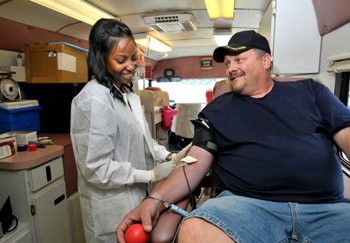
If you’ve given blood before, you’ve contributed to the 43,000 pints of blood donation used each day in the U.S. and Canada. Each one of those pints can save up to three lives, according to Virginia Blood Services (VBS).
Children, cancer patients undergoing chemotherapy and those who sustain serious trauma are most in need of blood donations. Hillary Maitland, MD, a UVA Cancer Center hematologist, specializes in non-cancerous blood disorders. She helped me understand the different components that make up an individual’s blood and the community effort it takes to stock UVA’s blood supply.
Blood Types
There are four main types of blood:
- A
- B
- AB
- O
Each blood type can be positive or negative. Maitland explains that blood transfusions must match the patient’s specific blood type. However, when there is not enough time to test a person’s blood type, doctors can use type O blood, because it’s compatible with both type A and type B.
According to VBS, O negative is the universal donor, and it’s in high demand for pediatric cancer patients, premature infants and children having heart surgery. “It’s important to have a lot of people in the community willing to donate so we have compatible blood for every blood type,” Maitland says.
What to Expect: The Process of Blood Donation
The entire donation process takes about an hour. It’s an easy act of kindness that could help save a life.
The donation process has four steps:
- Registration: All donors must present an ID at registration and fill out a questionnaire.
- Medical interview: A donor specialist reviews your questionnaire and checks your iron, blood pressure, temperature and pulse.
- Donation: A donor specialist prepares and cleans your arm for donation. The collection process takes about 10 minutes.
- Refreshments: After donation, you’ll receive refreshments like water, juice and snacks.
You can typically donate blood every few months, if you give your body enough time to replenish itself. “Any time people want to give blood would be a good time,” says Maitland. It can always be used, especially in times of crisis with multiple traumas.
Types O positive, O negative and B positive are frequently in short supply. If you have one of these blood types, you may be able to give two units at a time, which can help twice as many patients. However, this limits how frequently you can provide a blood donation.
Types of Blood Donation
Once you give blood, it undergoes a process to separate the different components.
Red Cells
Red cells carry oxygen to organs and tissues. It’s the most common type of transfusion, because it can treat anemia and blood loss from trauma or surgery.
Platelets
Platelets help create blood clots and are necessary for cancer patients undergoing chemotherapy or people receiving organ transplants. They can only be kept for five days and are constantly in need.
Plasma
Plasma is a watery fluid that transports cells. Transfusions replace lost blood volume, help to maintain blood pressure and assist with clotting, especially in trauma or accidents.
Plasma can be frozen for up to a couple months and thawed for transfusions or to make vaccines.
Blood Transfusions
“When you donate blood, it gets pooled with blood from a lot of different people and separated out into components, and that mixture of blood gets transfused to patients,” Maitland says. She explains that receiving pooled blood is safer than blood from one person, even a family member, because there are less foreign proteins and a lower risk of infection.
Patients don’t receive whole blood transfusions, just the specific component they need. Also, patients typically don’t receive white blood cells, which are removed before the transfusion process. Since white blood cells come from a person’s immune system, when they’re given to someone else, the cells recognize the white blood cell antibodies as abnormal and start an immune reaction.
“Blood donation is really so necessary. A lot of things have a synthetic alternative, but for blood, we really rely on other people’s donations,” says Maitland. “That and organ donation — those are the two things we really need people to step up and donate to.”

